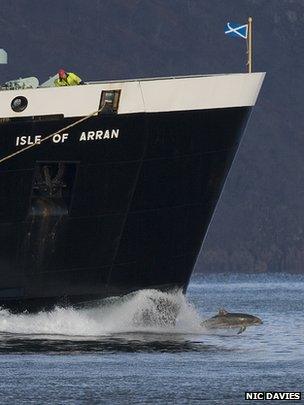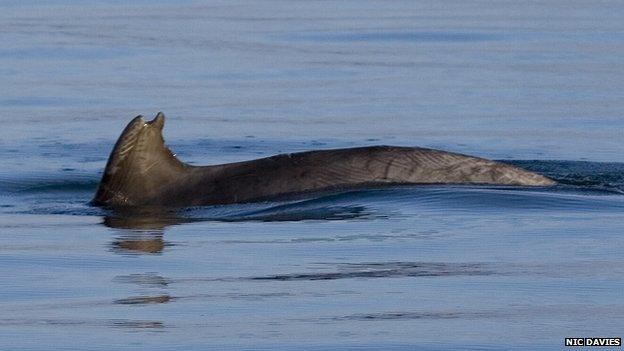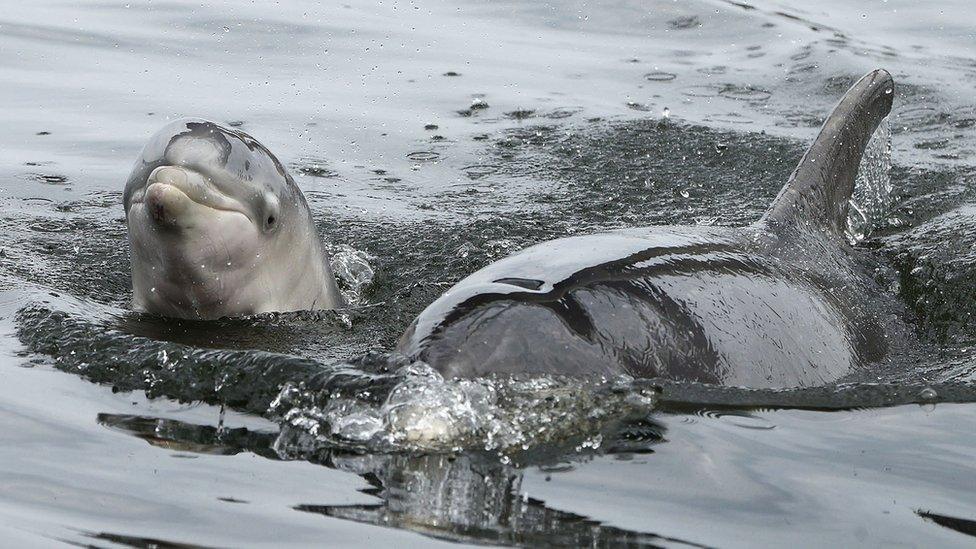Roaming bottlenose dolphin Clet turns up off Mull
- Published

The dolphin was seen off Mull on Tuesday
A solitary dolphin loved by fishermen in France but suspected of an "attack" on swimmers in the Republic of Ireland has turned up in Scottish waters.
The male bottlenose dolphin was named Clet by locals from Cap Sizun in Brittany where it followed fishing boats between 2008 and 2010.
It has since been seen off Cornwall and in September was believed to have been aggressive towards swimmers in Galway.
Earlier this week Clet was spotted in the sea off Mull.
The dolphin, which is identified by distinctive scarring on its dorsal fin, was photographed by wildlife photographer Nic Davies close to shore from Craignure on Mull.
Dolphin experts have described Clet's journey through European waters and his 372-mile (600km) swim from Galway to Mull as "remarkable".
The incident in Ireland on 28 September saw five swimmers taken to shore by the RNLI.
Witnesses said the dolphin circled the swimmers then swam at them in an "intimidating way".
The swimmers were not injured but were left frightened by the encounter.
The Hebridean Whale and Dolphin Trust has described some of the media coverage of the incident as "sensational".
It said solitary dolphins do not pose a threat to people in boats, but could be aggressive towards swimmers.
HWDT added that Clet's appearance off Mull on Tuesday was significant.

Clet has distinctive scarring
Dr Conor Ryan, the trust's sightings officer, said: "To our knowledge, this is the first time that Clet has been recorded in Scotland, and in fact this is the furthest north he has been recorded to date.
"Bottlenose dolphins are usually considered to be resident to certain areas, so long-distance international movements such as this challenge our understanding of this species, and also challenge our ability to protect them using Marine Protected Areas alone."
Photographer Mr Davies said: "I was out photographing otters when I heard a loud blow sound just out from the shore, and then I spotted the dolphin heading at speed towards a departing ferry."
Padraig Whooley, sightings officer for the Irish Whale and Dolphin Group, said: "We think it's remarkable that Clet's movements can be tracked to the Irish south and west coasts from France via English and Welsh waters, using images from the general public.
"The addition of Scotland after a two-month interval brings his known tally of passport stamps to five countries and counting, and shows the need for international collaboration when trying to monitor these highly mobile marine mammals."
Margaux Dodds, director and co-founder of the charity Marine Connection and co-author of a report on solitary dolphins, external, identified Clet when he first turned up off England's south coast.
She said that the animal's activity in Galway had been "misconstrued" and its behaviour was a form of defence and not an attack.
Bottlenose dolphins
Scotland is best known location for bottlenose dolphins is the Moray Firth on the east coast.
The firth and North Sea provide habitat for the world's most northerly resident population of bottlenose dolphins.
The species is protected by European Union rules.
The Moray Firth's population was declared as being "stable", according to a report published by Scottish Natural Heritage last month.
An estimated 102 individual dolphins used a Special Area of Conservation (SAC) in the firth during the summer of 2011, 112 in 2012 and 94 in 2013.
- Published28 November 2014

- Published2 October 2014
